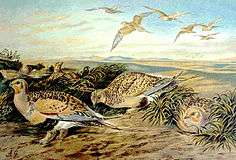Syrrhaptes
| Syrrhaptes | |
|---|---|
 | |
| Pallas's sandgrouse | |
| Scientific classification | |
| Kingdom: | Animalia |
| Phylum: | Chordata |
| Class: | Aves |
| Order: | Pteroclidiformes |
| Family: | Pteroclididae |
| Genus: | Syrrhaptes Illiger, 1811 |
| Species | |
|
Syrrhaptes tibetanus | |
Syrrhaptes is a genus of birds in the sandgrouse family. The genus name is from Ancient Greek surrhaptos, "sewn together"; the feathered toes of birds in this genus are fused together.[1]
There are two central Asian species.
- Tibetan sandgrouse, Syrrhaptes tibetanus
- Pallas's sandgrouse, Syrrhaptes paradoxus
These are large birds breeding in open steppes or plateau. They nest in a ground scrape into which three eggs are laid.
Both species have mainly buff upperparts, an orange face and feathered legs and toes. They are smaller-headed than other sandgrouse, but have sturdy compact bodies.
The small feet lack a hind toe, and the three front toes are fused together. The upper surface is feathered, and the underneath has a fleshy pad. The appearance of the foot is more like a paw than an avian foot.[2]
Although there is range overlap, they are easily distinguished. Tibetan sandgrouse has a white belly and black underwings, whereas Pallas's has a black belly and white underwings.
These birds are gregarious like other sandgrouse. Flocks fly to watering holes at dawn and dusk, on long pointed wings.